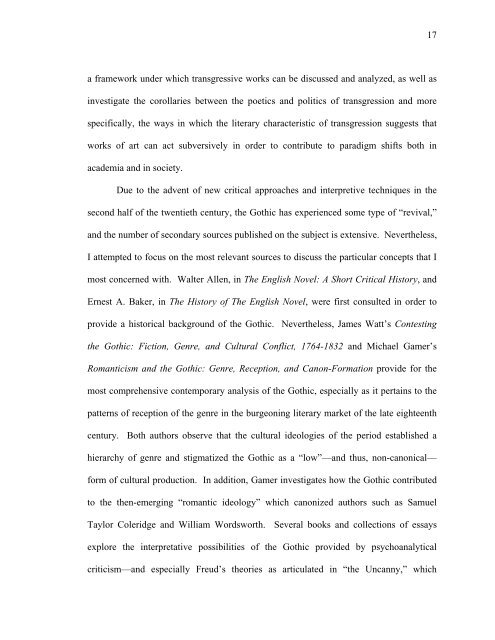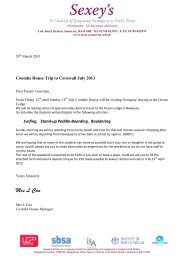Untitled - Sexey's School Moodle
Untitled - Sexey's School Moodle
Untitled - Sexey's School Moodle
You also want an ePaper? Increase the reach of your titles
YUMPU automatically turns print PDFs into web optimized ePapers that Google loves.
a framework under which transgressive works can be discussed and analyzed, as well as<br />
investigate the corollaries between the poetics and politics of transgression and more<br />
specifically, the ways in which the literary characteristic of transgression suggests that<br />
works of art can act subversively in order to contribute to paradigm shifts both in<br />
academia and in society.<br />
Due to the advent of new critical approaches and interpretive techniques in the<br />
second half of the twentieth century, the Gothic has experienced some type of “revival,”<br />
and the number of secondary sources published on the subject is extensive. Nevertheless,<br />
I attempted to focus on the most relevant sources to discuss the particular concepts that I<br />
most concerned with. Walter Allen, in The English Novel: A Short Critical History, and<br />
Ernest A. Baker, in The History of The English Novel, were first consulted in order to<br />
provide a historical background of the Gothic. Nevertheless, James Watt’s Contesting<br />
the Gothic: Fiction, Genre, and Cultural Conflict, 1764-1832 and Michael Gamer’s<br />
Romanticism and the Gothic: Genre, Reception, and Canon-Formation provide for the<br />
most comprehensive contemporary analysis of the Gothic, especially as it pertains to the<br />
patterns of reception of the genre in the burgeoning literary market of the late eighteenth<br />
century. Both authors observe that the cultural ideologies of the period established a<br />
hierarchy of genre and stigmatized the Gothic as a “low”—and thus, non-canonical—<br />
form of cultural production. In addition, Gamer investigates how the Gothic contributed<br />
to the then-emerging “romantic ideology” which canonized authors such as Samuel<br />
Taylor Coleridge and William Wordsworth. Several books and collections of essays<br />
explore the interpretative possibilities of the Gothic provided by psychoanalytical<br />
criticism—and especially Freud’s theories as articulated in “the Uncanny,” which<br />
17



